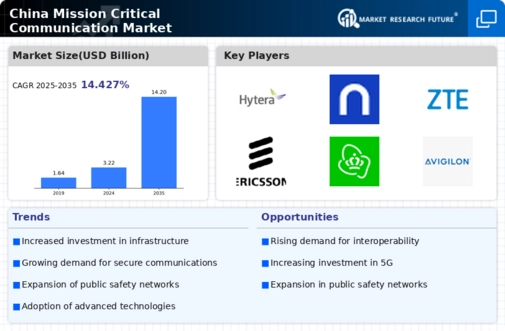Collaboration Among Stakeholders
Collaboration among various stakeholders, including government agencies, private companies, and technology providers, is emerging as a significant driver for the mission critical-communication market. In China, partnerships are being formed to develop integrated communication solutions that address the unique challenges faced by emergency services. These collaborations facilitate knowledge sharing and resource pooling, leading to the creation of more effective communication systems. The mission critical-communication market is expected to benefit from this trend, as stakeholders work together to enhance interoperability and system reliability. Market forecasts suggest that such collaborative efforts could result in a market growth rate of around 18% over the next few years.
Increased Focus on Public Safety
The growing emphasis on public safety in China is a crucial driver for the mission critical-communication market. Recent incidents have highlighted the need for effective communication systems to ensure timely responses to emergencies. As a result, both government and private entities are prioritizing investments in communication infrastructure to enhance public safety measures. This focus is reflected in the increasing budgets allocated for emergency services, with reports indicating a rise of 30% in funding for communication technologies in the last two years. Consequently, the mission critical-communication market is likely to see sustained growth as organizations seek to implement more reliable and efficient communication solutions.
Government Initiatives and Policies
The mission critical-communication market in China is significantly influenced by government initiatives aimed at enhancing public safety and emergency response capabilities. The Chinese government has been actively investing in communication infrastructure, with a reported allocation of over $10 billion for the development of advanced communication networks. This investment is expected to bolster the capabilities of first responders and emergency services, ensuring seamless communication during crises. Furthermore, policies promoting the adoption of digital technologies in public safety sectors are likely to drive the demand for mission critical-communication solutions. As a result, the market is poised for growth, with projections indicating a compound annual growth rate (CAGR) of approximately 15% over the next five years.
Rising Urbanization and Population Density
China's rapid urbanization and increasing population density are pivotal factors driving the mission critical-communication market. As urban areas expand, the need for efficient communication systems becomes paramount to manage public safety and emergency services effectively. With over 60% of the population now residing in urban centers, the demand for robust communication networks is escalating. This trend necessitates the implementation of advanced communication technologies to ensure reliable connectivity for emergency responders. The mission critical-communication market is expected to benefit from this urban growth, with market analysts estimating a potential increase in demand by 20% in urban regions over the next few years.
Technological Advancements in Communication
The mission critical-communication market is experiencing a surge in demand due to rapid technological advancements. Innovations such as 5G technology, artificial intelligence, and the Internet of Things (IoT) are transforming communication systems, making them more efficient and reliable. In China, the rollout of 5G networks is anticipated to enhance the capabilities of mission critical-communication systems, enabling real-time data sharing and improved situational awareness for emergency responders. This technological evolution is likely to attract investments from both public and private sectors, further propelling market growth. Analysts predict that the integration of these technologies could lead to a market expansion of approximately 25% by 2027.






















Leave a Comment